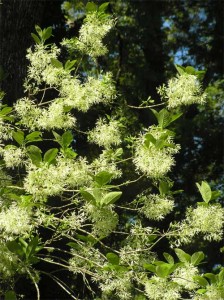Influenced by African-American gardens
Originally published February 19, 2009

Grancy graybeard (fringe tree), a popular small tree collected from the woods for African-American gardens, is often seen in Carrboro front yards. Photo by Ken Moore
By Ken Moore
Talking about the upcoming “African-American Gardening†presentation by University of Georgia professor emeritus Richard Westmacott, gardening friend Juel Duke and I discovered that we share a similar Southern gardening heritage.
Juel grew up near Norlina remembering seeing all the interesting and colorful plants and yard ornaments throughout rural Warren County. At the age of 3, I began spending my summers in Warren County with my widowed aunt who shared her small tobacco farm with two African-American tenant families.
As Westmacott describes in his book, the term “garden†in the rural South referred to an area away from the house managed for the production of vegetables. Flowers were grown in the “yard,†generally in front of the house where, when there was time, families enjoyed sitting on the porch welcoming passers-by.
Backyards were generally used for practical activities, such as washing clothes, feeding the chickens and harvesting and processing vegetables. The yards were swept clean to prevent the growth of weeds and grass. There was generally a shade tree or two beneath which occurred the daily chores.
My aunt had a huge vegetable garden, and weeding it was not fun; but I liked picking the strawberries. Two long rows of marigolds and zinnias separated the garden from the yard around the house. My aunt had no time for yard ornaments, but my dad enjoyed surrounding flower beds with painted rocks in our yard up in suburban Richmond. He also collected concrete figures to station around the yard, but he never had a tire planter; I have four of which I’m very proud!
In the old days, folks didn’t have ready access to garden centers or extra money to purchase flowers and shrubs, so they shared “pass-along plants†or took to the local woods to collect desirable plants. In addition to dogwoods and redbuds and wild azaleas, Westmacott describes rural folks favoring “grancy graybeard†collected from the woods to be planted on the edge of the yard. It’s been a long time since I heard that common name for fringe tree, Chionanthus virginicus, a popular small native tree commonly available in garden centers today.
There is a grand old specimen of fringe tree on the edge of my front yard. My hunch is that it was brought out of the woods behind the house, now the University Lake watershed, and planted along with two southern sugar maples, from the same woods, back when the house was built in the late 1930s. Later this spring, you will notice a number of big fringe trees in some of the older front yards of Carrboro. They probably all came out of the local woods when grancy greybeard, not available elsewhere, was prized as a fine ornamental.
Rural African-Americans had colorful yards filled with yard art, often considered cheap or tacky. They were, however, in all cases, personal artistic expressions of pride and welcoming invitations for neighbors to stop and sit a spell.
Juel and I take great pride in retelling the histories of our hand-me-down and collected plants and we love the stories behind all our yard objects d’art. We appreciate our African-American gardening heritage.
For more information and to register for Richard Westmacott’s “African-American Gardening†this coming Sunday, Feb. 22, call the Botanical Garden at 962-0522.

Juel Duke’s patio garden of pitcher plants in containers, bidding one to “sit a spell.†Photo by Juel Duke
Comments are closed.